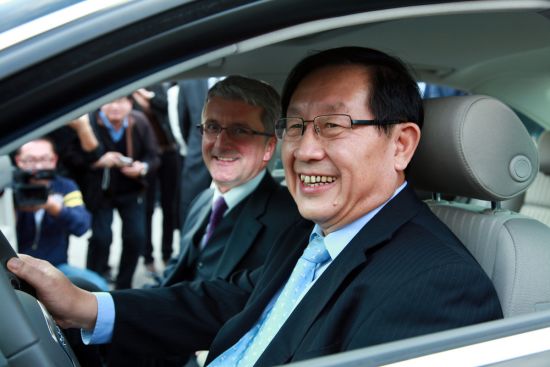China's Great Electrification Drive: 1 Million Electric Cars By 2015

India is keeping a wary eye on their neighbor north of the Himalaya. The Indian press is usually not prone to hyping Chinese achievements. Therefore, this news item should give us reason to sit up and take notice. China will shortly announce a plan to sell a million electric cars annually from 2015 on out. That’s what India’s Economic Times says.
People’s Daily confirms the report: “Under the country’s latest plan for the auto industry, to be rolled out at the end of 2010, new energy vehicles will be the top priority.”
As the fate of BYD illustrates, the Chinese are not necessarily lining up to buy EVs. Even generous incentives did not change their minds. They want affordable, reliable transportation. To achieve the goal, the Chinese government, and the Chinese auto industry have their work cut out for themselves. But knowing the Chinese, if they put their mind to something …
To get things rolling, 20,000 new energy vehicles, mostly electric buses, will hit Chinese roads by the end of the year.
One million EVs a year sound aggressive. But you need to keep Chinese numbers in mind. This year, they will sell more than 17m units. Even if you use a very conservative growth rate of 10 percent per year (and China gets nervous if growth falls below 10 percent,) the Chinese market will be good for 27m cars by 2015. One million EVs would mean a market penetration of 3.6 percent, in line with what other augurs predict for other markets. Those markets just won’t be as huge as the Chinese.
According to the Economic Times, “by 2020, China is aiming to reduce energy consumption by 50 per cent, and slash fuel consumption to five litres per 100 km.” By then, Chinese planners hope that new energy vehicles will replace 20 percent of traditional cars in China, and electricity will become the main substitute for gasoline.
It won’t be all EVs. Under the soon to be announced plan, “new energy” vehicles encompass EVs and hybrids.
The man behind the plan: China’s Science & Technology Minister Wan Gang. He’s probably the highest level “car guy” any government has. He has a Ph. D. in automotive engineering from Germany’s respected Clausthal University of Technology. In 1991, he went to work for Audi in Ingolstadt and had a big hand in the development of the A4. In 2004, he became President of Shanghai’s Tongji University, a hotbed of Chinese car research, especially in the new energy field.
In 2007, he received a call to report to the central government in Beijing the next day. A reason was not given. Wan Gang, who is not a member of the CCP, embarked on the trip with great apprehension. On arrival in Beijing, he was told that he was appointed Minister of Science and Technology.
I happened to have been at Tongji’s Automotive College in Anting on that day. You could hear a sigh of relief, followed by loud cheers all the way through the sprawling campus.

Bertel Schmitt comes back to journalism after taking a 35 year break in advertising and marketing. He ran and owned advertising agencies in Duesseldorf, Germany, and New York City. Volkswagen A.G. was Bertel's most important corporate account. Schmitt's advertising and marketing career touched many corners of the industry with a special focus on automotive products and services. Since 2004, he lives in Japan and China with his wife <a href="http://www.tomokoandbertel.com"> Tomoko </a>. Bertel Schmitt is a founding board member of the <a href="http://www.offshoresuperseries.com"> Offshore Super Series </a>, an American offshore powerboat racing organization. He is co-owner of the racing team Typhoon.
More by Bertel Schmitt
Latest Car Reviews
Read moreLatest Product Reviews
Read moreRecent Comments
- 1995 SC If the necessary number of employees vote to unionize then yes, they should be unionized. That's how it works.
- Sobhuza Trooper That Dave Thomas fella sounds like the kind of twit who is oh-so-quick to tell us how easy and fun the bus is for any and all of your personal transportation needs. The time to get to and from the bus stop is never a concern. The time waiting for the bus is never a concern. The time waiting for a connection (if there is one) is never a concern. The weather is never a concern. Whatever you might be carrying or intend to purchase is never a concern. Nope, Boo Cars! Yeah Buses! Buses rule!Needless to say, these twits don't actual take the damn bus.
- MaintenanceCosts Nobody here seems to acknowledge that there are multiple use cases for cars.Some people spend all their time driving all over the country and need every mile and minute of time savings. ICE cars are better for them right now.Some people only drive locally and fly when they travel. For them, there's probably a range number that works, and they don't really need more. For the uses for which we use our EV, that would be around 150 miles. The other thing about a low range requirement is it can make 120V charging viable. If you don't drive more than an average of about 40 miles/day, you can probably get enough electrons through a wall outlet. We spent over two years charging our Bolt only through 120V, while our house was getting rebuilt, and never had an issue.Those are extremes. There are all sorts of use cases in between, which probably represent the majority of drivers. For some users, what's needed is more range. But I think for most users, what's needed is better charging. Retrofit apartment garages like Tim's with 240V outlets at every spot. Install more L3 chargers in supermarket parking lots and alongside gas stations. Make chargers that work like Tesla Superchargers as ubiquitous as gas stations, and EV charging will not be an issue for most users.
- MaintenanceCosts I don't have an opinion on whether any one plant unionizing is the right answer, but the employees sure need to have the right to organize. Unions or the credible threat of unionization are the only thing, history has proven, that can keep employers honest. Without it, we've seen over and over, the employers have complete power over the workers and feel free to exploit the workers however they see fit. (And don't tell me "oh, the workers can just leave" - in an oligopolistic industry, working conditions quickly converge, and there's not another employer right around the corner.)
- Kjhkjlhkjhkljh kljhjkhjklhkjh [h3]Wake me up when it is a 1989 635Csi with a M88/3[/h3]






























Comments
Join the conversation
After living in China, I only wish America's government could be more like them. China WILL accomplish this. America's government will simply bicker back and forth to placate their environmentalists special interests or their big oil conservatives. Nothing will be accomplished and we'll be stuck on Middle Eastern oil indefinitely. We can't even keep our roads in as good a condition as they do.